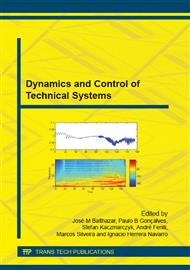[1]
J. R. Wertz, Spacecraft attitude determination and control (Astrophysics and Space Science Library), London, D. Reidel, (1978).
Google Scholar
[2]
V. Carrara and P. G. Milani, Control of one-axis air bearing table equipped with gyro and reaction wheel (In Portuguese), Proceedings of V SBEIN – Brazilian Symposium on Inertial Engineering. Rio de Janeiro, Brazil, Nov. (2007).
Google Scholar
[3]
V. Carrara, Comparison between means of attitude control with reaction wheels (In Portuguese), Proceedings of VI SBEIN - Brazilian Symposium on Inertial Engineering. Rio de Janeiro, Brazil, Nov. (2010).
Google Scholar
[4]
V. Carrara, R. Siqueira, D. Oliveira, Speed and current mode strategy comparison in satellite attitude control with reaction wheels. Proceedings of COBEM 2011 – 21st Brazilian Congress of Mechanical Engineering. Natal, RN, Brazil, Oct. (2011).
Google Scholar
[5]
M. L. B. Moreira, R. V. F. Lopes and H. K. Kuga, Estimation of torque in a reaction wheel using a Bristle model for friction, Proceedings of 18th International Congress of Mechanical Engineering, Ouro Preto, Brazil, Nov. (2005).
Google Scholar
[6]
S. S. Ge and H. Cheng, A Comparative Design of a Satellite Attitude Control System with Reaction Wheel. Proceedings of the First NASA/ESA Conference on Adaptive Hardware and Systems – AHS'06 (2006). (ISBN 0-7695-2614-4/06).
DOI: 10.1109/ahs.2006.2
Google Scholar
[7]
H. Olsson, K. J. Åström, C. Canudas de Wit, M. Gafvert and P. Lischinsky, Friction models and friction compensation, European Journal of Control, Vol. 4, No. 3 (1998) 176-195.
DOI: 10.1016/s0947-3580(98)70113-x
Google Scholar
[8]
C. Canudas de Wit and S. S. Ge, Adaptive friction compensation for system with generalized velocity/position friction dependency, Proceedings of the 36th Conference on Decision and Control, San Diego, CA, Dec. (1997) 2465-2470.
DOI: 10.1109/cdc.1997.657526
Google Scholar
[9]
C. Canudas De Wit, H. Olsson, K. J. Åström and P. Lischinsky, A New Model for Control of Systems with Friction, IEEE Transactions on Automatic Control, Vol. 40, No. 3 (1995) 419-425.
DOI: 10.1109/9.376053
Google Scholar
[10]
C. Canudas De Wit and P. Lischinsky, Adaptive Friction Compensation with Partially Known Dynamic Friction Model, International Journal of Adaptive Control and Signal Processing, Vol. 11 (1997) 65-80.
DOI: 10.1002/(sici)1099-1115(199702)11:1<65::aid-acs395>3.0.co;2-3
Google Scholar
[11]
K. J. Åström and C. Canudas de Wit, Revisiting the LuGre Friction Model, IEEE Control Systems Magazine, Dec. (2008) 101-114.
DOI: 10.1109/mcs.2008.929425
Google Scholar
[12]
V. Carrara, A. G. Silva and H. K. Kuga, A Dynamic Friction Model for Reaction Wheels. Advances in the Astronautical Sciences. Vol 145. 1st IAA Conference on Dynamics and Control of Space Systems – DyCoSS'2012. Porto, Portugal, March (2012).
Google Scholar
[13]
D. Karnopp, Computer simulation of slip-stick friction in mechanical dynamic systems. Journal of Dynamic Systems, Measurement, and Control, Vol. 107, No. 1 (1985) 100–103.
DOI: 10.1115/1.3140698
Google Scholar
[14]
F. Al-Bender, V. Lampaert and J. Swevers, The Generalized Maxwell-Slip Model: A Novel Model for Friction Simulation and Compensation. IEEE Transactions on Automatic Control, Vol. 50, No. 11, Nov. (2005).
DOI: 10.1109/tac.2005.858676
Google Scholar
[15]
R. M. Hirschorn and G. Miller, Control of nonlinear systems with friction. IEEE Transactions on Control Systems Technology, Vol. 7, No. 5 (1999) 588-595.
DOI: 10.1109/87.784422
Google Scholar
[16]
E. Oland and R. Schlanbusch, Reaction wheel design for cubesats. 4th International Conference on Recent Advances in Space Technologies, 2009. RAST'09., IEEE (2009) 588-595.
DOI: 10.1109/rast.2009.5158296
Google Scholar
[17]
V. Carrara and H. K. Kuga, Estimating friction parameters in reaction wheels for attitude control. Mathematical Problems in Engineering, Vol. 2013, pp.1-8, 2013. doi: /101155/2013/249674.
DOI: 10.1155/2013/249674
Google Scholar


